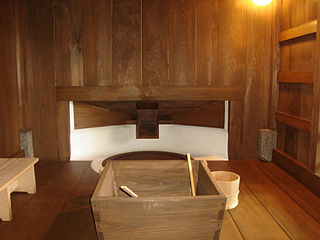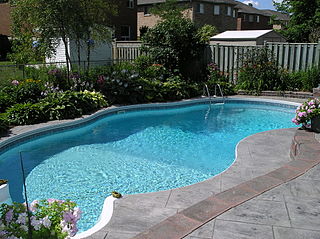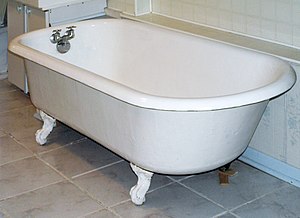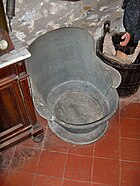
A sink is a bowl-shaped plumbing fixture for washing hands, dishwashing, and other purposes. Sinks have a tap (faucet) that supply hot and cold water and may include a spray feature to be used for faster rinsing. They also include a drain to remove used water; this drain may itself include a strainer and/or shut-off device and an overflow-prevention device. Sinks may also have an integrated soap dispenser. Many sinks, especially in kitchens, are installed adjacent to or inside a counter.

A bathroom, restroom or washroom is a room, typically in a home or other residential building, that contains either a bathtub or a shower. The inclusion of a sink is common. In parts of the world e.g. India, a toilet is typically included in the bathroom; in others, the toilet is typically given a dedicated room separate from the one allocated for personal hygiene activities. In the United States and Canada, the word "bathroom" is often used to refer to any room that contains a toilet, regardless of the inclusion of a bath or shower.

A shower is a place in which a person bathes under a spray of typically warm or hot water. Indoors, there is a drain in the floor. Most showers have temperature, spray pressure and adjustable showerhead nozzle. The simplest showers have a swivelling nozzle aiming down on the user, while more complex showers have a showerhead connected to a hose that has a mounting bracket. This allows the showerer to hold the showerhead by hand to spray the water onto different parts of their body. A shower can be installed in a small shower stall or bathtub with a plastic shower curtain or door. Showering is common due to the efficiency of using it compared with a bathtub. Its use in hygiene is, therefore, common practice.

Kohler Co., founded in 1873 by John Michael Kohler, is an American manufacturing company based in Kohler, Wisconsin. Kohler is best known for its plumbing products, but the company also manufactures furniture, cabinetry, tile, engines, and generators. Destination Kohler also owns various hospitality establishments in the United States and Scotland. In February 2017, Kohler Co. acquired UK-based Clarke Energy from the management team and ECI Partners, a multinational specialist in the engineering, construction, installation, and maintenance of engine-based power plants and is an authorized distributor of GE's reciprocating engines in 19 countries worldwide. In November 2023, it was announcing that Kohler is establishing the Energy group independently and would be bought in a complex partnership with private equity group Platinum Equity, the deal is slated to close in Q1 2024.

Bathing is the act of washing the body, usually with water, or the immersion of the body in water. It may be for personal hygiene, religious ritual or therapeutic purposes. By analogy, especially as a recreational activity, the term is also applied to sun bathing and sea bathing.

Jacuzzi is an American private company that manufactures and markets hot tubs, pools, and other bath products. It is best known for the Jacuzzi hydrotherapy products. The company is headquartered in Irvine, California. It is the largest hot tub manufacturer in Europe with eight factories, the largest being in Italy.

Public baths originated when most people in population centers did not have access to private bathing facilities. Though termed "public", they have often been restricted according to gender, religious affiliation, personal membership, and other criteria.

A spa is a location where mineral-rich spring water is used to give medicinal baths. Spa towns or spa resorts typically offer various health treatments, which are also known as balneotherapy. The belief in the curative powers of mineral waters goes back to prehistoric times. Such practices have been popular worldwide, but are especially widespread in Europe and Japan. Day spas and medspas are also quite popular, and offer various personal care treatments.

A hot tub is a large tub full of water used for hydrotherapy, relaxation or pleasure. Some have powerful jets for massage purposes. Hot tubs are sometimes also known as "spas" or by the trade name Jacuzzi. Hot tubs may be located outdoors or indoors.

A bubble bath is a filled bathtub with a layer of soap bubbles on the surface of the water. Less commonly, aerated or carbonated baths are called bubble baths.

Furo, or the more common and polite form ofuro, is a Japanese bath and/or bathroom. Specifically it is a type of bath which originated as a short, steep-sided wooden bathtub. Baths of this type are found all over Japan in houses, apartments and traditional Japanese inns (ryokan) but are now usually made out of a plastic or stainless steel.

Bathhouse Row is a collection of bathhouses, associated buildings, and gardens located at Hot Springs National Park in the city of Hot Springs, Arkansas. The bathhouses were included in 1832 when the Federal Government took over four parcels of land to preserve 47 natural hot springs, their mineral waters which lack the sulphur odor of most hot springs, and their area of origin on the lower slopes of Hot Springs Mountain.

A swimming pool, swimming bath, wading pool, paddling pool, or simply pool, is a structure designed to hold water to enable swimming or other leisure activities. Pools can be built into the ground or built above ground, and may be found as a feature aboard ocean-liners and cruise ships. In-ground pools are most commonly constructed from materials such as concrete, natural stone, metal, plastic, composite or fiberglass, and can be of a custom size and shape or built to a standardized size, the largest of which is the Olympic-size swimming pool.
Bathtub refinishing is a process of restoring the surface of a bathtub to improve its appearance and durability. It involves applying a new coating or finish on the existing bathtub surface, which can be made of materials such as porcelain, fiberglass, acrylic, or enamel.
Accessible bathtubs are bathtubs that can be used by people with limited mobility, disabilities, and the elderly. A bathtub can be made accessible for some people by the addition of grab bars or hand grips, or through the use of lifts that lower and raise the bather in the water. Other bathtubs have been specially designed for accessibility. These may include walk-in bathtubs, tubs with built-in transfer benches, or, more recently, tubs with raised beds and sliding doors to allow for a seated transfer.

A shower splash guard is a permanently installed, fixed, rigid fitting made of plastic or glass that prevent water from a shower from splashing out of the bathtub and onto the floor. Typically, the shower splash guard is a small triangular piece of plastic that is used in combination with a shower curtain, to prevent water escaping at the corners, but it may be a much larger piece that is used by itself.
Up-N-Away was the name of a vertical-sliding bath/shower door manufactured by Unitspan Architectural Systems, Inc. The bathtub shower doors had vertical tracks instead of horizontal, and closed downward or opened upwards rather than sideways. The channel tracks were vertical on each side with only a low profile sill necessary across the front rim of the tub enclosure to direct water back into tub when in use with door closed; this enabled the entire front edge/rim of tub enclosure to be relatively flat when the doors were open. This design was also to make the front edge/rim of tub to always be clean as well as comfortable to sit on when bathing a child. The vertical-sliding doors were counterbalanced to be kept up and out of the way for an elegant look, but slid to lower positions for showering. Within the vertical track channels, the lower left and right edge of each sliding door attached to counterweighted ropes with nylon hanger brackets. The downward-closing bath shower doors aimed to solve the disadvantages of conventional, sideways-sliding doors to provide more convenience, relaxation and luxury. They were at first marketed on a store- or factory-to-consumer basis, with do-it-yourself installation required.
Bathtub liners also known as tub liners, acrylic tub liners and tub inserts are made by vacuum forming an acrylic or PVC sheet which is heated then formed in a mold by applying vacuum. Having the proper mold is important for the tub liner to fit properly. Typically, a bathtub liner will fall between the cost of replacing a bathtub at the high end and bathtub refinishing at the lower end in cost when renovating a damaged or outdated bathtub.
Morris Benjamin Wilkins was the inventor of the heart-shaped bathtub and the champagne glass bathtub. He is credited for helping establish the Pocono Mountains in northeast Pennsylvania as the "honeymoon capital of the world."
Max Takes a Bath, also known by the title By the Doctor's Orders, is a French silent film directed by Lucien Nonguet and produced by the Pathé Frères company in 1910. This approximately seven minute long film was released in France and marks the beginnings of many trends that would become increasingly popular for cinema, such as the optical effect of the vertical vantage point. It also illustrates the start of Max Linder's popularity. Max Linder is one of the earliest, widely recognized and popular French film stars. Additionally, Linder was the first actor whose name could be used for advertisements which helped launch the success of what would become one of the most popular film genres of all time; the comedy.




















